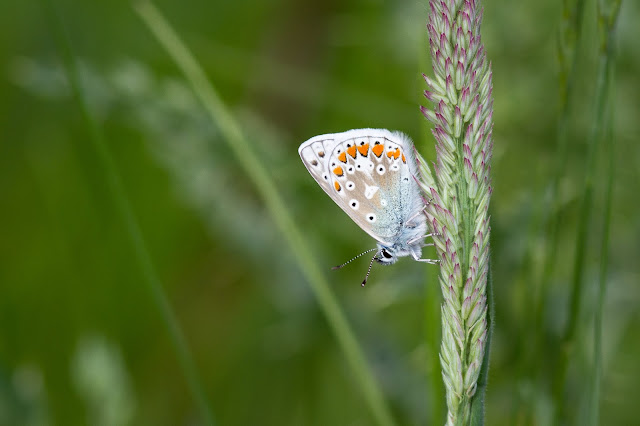I wasn't the only one walking round the pond this week. As I left I looked back and saw a fox on the far side of the big pond. It was 3 o'clock in the afternoon and I guess the fox was looking for eggs or young birds.
I was hiding behind the hedge but eventually he saw me or heard the camera and made off. I carry only a 300mm lens so the photos are a bit distant.
The geese had also spotted the fox and the parents took the goslings back onto the water to stay safe.
I didn't see the little grebes this week so I don't know how they are faring, although I could hear them calling in the reeds. Other birds flying over included a buzzard and a curlew.
The broad-bodied chasers were still around, although still hunting away from the water.
There were a dozen or two four-spotted chasers around the ponds.
Lots and lots of large red damselflies
and common blues.
Fewer azure damselflies
and only a handful of blue-tailed damselflies.
New butterflies this week were a small heath
and a male common blue.
I did the monthly BeeWalk for the Bumblebee Conservation Trust this week, walking a 1km transect around the ponds and the adjacent bridle path. Most bees were either common carders (Bombus pascuorum)
or red-tailed bumblebees (Bombus lapidarius).
Both the above are easy to recognise but I always carry the camera when looking for bumblebees. Any that are black and yellow with a white tail are a bit more of a challenge. I only saw this one for a moment but looking at the photos I can identify it as Barbut's cuckoo bumblebee (Bombus barbutellus), a parasite of Bombus hortorum, the garden bumblebee..
This early bumblebee (Bombus pratorum) was foraging on water avens (Geum rivulare).

Here is a little beast that pretends to be a bumblebee but is a hoverfly (Volucella bombylans var. plumata) and is a mimic of a white-tailed or buff-tailed bumblebee.
Another new finding this week was this sexton beetle (Nicrophorus sp). It was resting on hawthorn but doesn't feed on flowers. Also known as burying beetles, sexton beetles locate corpses of birds and small rodents and dig the soil away underneath them to bury the bodies. They lay their eggs in the bodies which then provide food for the beetle larvae. Unusually for an insect, the adult beetles stay around to look after the developing larvae.
This one is carrying a few passengers - beetle mites (Pergamasus crassipes). They are hitching a lift to the carrion where they will also lay their eggs. The mites don't harm the beetle and may even help it as the mite larvae eat maggots that would otherwise compete with the beetle larvae for the food.
I reckon this is pretty efficient recycling. You can watch an amazing short time-lapse video of a sexton beetle burying a corpse here.
























No comments:
Post a Comment